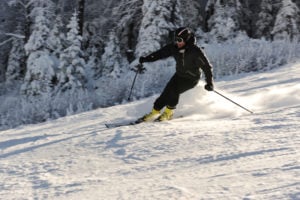 The Ski Season is fast approaching! If you’re anything like me, the cooler weather gives you something to smile about as you anticipate cruising down the mountain at top speed on your skis or snowboard. So whether you’re a weekend warrior, planning a ski week or going to do a full snow season, getting into a pre-season training programme now will benefit you greatly. Not only will you be able to perform better on the snow, but you’ll be less likely to sustain common snow sport injuries. The focus should be on: general fitness; leg and core strength; balance, coordination and flexibility.
The Ski Season is fast approaching! If you’re anything like me, the cooler weather gives you something to smile about as you anticipate cruising down the mountain at top speed on your skis or snowboard. So whether you’re a weekend warrior, planning a ski week or going to do a full snow season, getting into a pre-season training programme now will benefit you greatly. Not only will you be able to perform better on the snow, but you’ll be less likely to sustain common snow sport injuries. The focus should be on: general fitness; leg and core strength; balance, coordination and flexibility.
What should you be doing? No matter what level of fitness you already have, here are some tips and exercises to get going on. We will start with some cardiovascular exercise, some leg strengthening and balance work.
Cardiovascular exercise – Good cardiovascular fitness will ensure a more enjoyable day on the slopes, as you won’t fatigue too quickly. I recommend starting 3 sessions per week of at least 30 minutes, and build up to 5 sessions of 45 minutes over the next 6 weeks. You could try fast walking, jogging, stair climbing, cycling, roller blading (particularly good as this mimics skiing technique), cross trainer or even swimming.
Leg Strength – most important for skiing and snowboarding:
- Lunges – these are great for leg strengthening and also for developing good hip and back stability. Try a set of 10 walking or travelling lunges. You can add hand weights. Repeat 3 times.
- Squats – you can do these against a wall with an exercise ball behind your back, or free with small hand weights. Make sure you keep your back straight and sit back into the squat. Go as low as your knees allow. Repeat 15 times and do 3 sets.
- Wall Sits – This is an excellent way to build quad strength, and will help prevent leg burn when you make it to the snow. Sit against a wall with your knees and hips at 90 degrees. Aim for one minute sitting and try to increase this by 10 seconds per week. Repeat 3 times.
Balance – Start practising standing on one leg with control for as long as you can. If this is too easy, try it with your eyes shut. If this is too easy, stand on a cushion or a mini-tramp to further challenge your balance skills. This will really help for when you’re attempting to stay upright on uneven terrain.
Good luck with your exercises!





